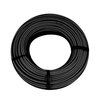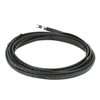100’ Roof and Gutter Deicing Self-Regulating Heating Cable, 5W/ft., 120V
How Much Cable Will I Need?

For each area listed in the table below, measure the required dimensions using the diagram above and calculate the length of cable needed. Add each "area" calculation to determine the total cable length needed.
| Area | What to Measure | How to Calculate |
|---|---|---|
| Along Roof | Overhang (A) Length along roof (B) |
Length of roof (B) X Overhang Multiplier |
| Dormer | Distance around dormer (C) | Number of dormers X Distance around dormer(s) (C) |
| Valley | Number of valleys (D) | Number of valleys (D) X 6 ft. or 1.8M |
| Downspouts | Number of downspouts Length of downspouts (E) |
Number of downspout (E) X 2 |
If ice is building up in gutters only, calculate the length of cable needed for each area listed in the table below. Add each "area" calculation to determine the total cable length needed.
| Area | How to Calculate |
|---|---|
| Gutter | Length of gutter (B) X2 |
| Downspouts | Number of downspouts X Length of downspout (E) X2 |
For each area listed in table below, measure the required dimensions using the diagram above and calculate the length of cable needed. Add each "area" calculation to determine the total cable length needed.
| Area | What to Measure | How to Calculate |
|---|---|---|
| Along Roof | Overhang (A) Along roof (B) |
Length of roof (B) X Overhang Multiplier |
| Dormer | Distance around dormer (C) | Number of dormers X Distance around dormer(s) (C) |
| Valley | Number of valleys (D) | Number of valleys (D) X 6 ft. or 1.8 m |
| Downspouts | Number of downspouts Length of downspouts from roof to ground (E) |
Number of downspouts X Length of downspout (E) X 2 |
| Special roof areas (such as skylights) | Distance from roof edge to bottom of special roof area (F) Width of ice dams that form along special roof area (G) |
Distance from roof edge to bottom of special roof area (F) X Width of ice dams to form along special roof area (G) X Special Roof Area Multiplier |
Features
-
Helps protect your roof and gutters from damages caused by ice formation
-
This 100’ length of 120V heating cable is ideal for use with 20’ roofline with zigzag overhang coverage with single runs through the gutter and downspout
-
Can be trimmed to length (with accessories) at the jobsite by the installer
-
This cable has a nominal output of 5 watts per linear foot at 50°F (10°C)
-
Covered by a 10-year warranty
Notices
Quebec Repairability Notice
Avis important pour les consommateurs du Québec:
WarmlyYours n’offre pas de services de réparation pour ce produit. Les seules pièces de rechange disponibles sont les clips d’installation et les entretoises ; le câble chauffant lui-même n’est pas offert comme pièce de rechange. Si votre câble de déglaçage de toit et de gouttière tombe en panne pendant la période de garantie, nous remplacerons l’unité complète conformément à notre politique de garantie. Notre équipe d’assistance technique est disponible 24h/24 et 7j/7 par téléphone pour toute aide à l’installation ou au dépannage. Pour plus de détails, consultez notre politique de retour. Cet avis est fourni conformément à la Loi sur la protection du consommateur du Québec, article 39 (telle qu’amendée en 2025).
Important Notice for Québec Consumers:
WarmlyYours does not provide repair services for this product. The only replacement parts available are installation clips and spacers; the heating cable itself is not available as a replacement part. If your roof and gutter deicing cable fails within the warranty period, we will replace the entire unit according to our warranty policy. Our technical support team is available 24/7 by phone for installation and troubleshooting assistance. For full details, see our Return Policy. This notice is provided in accordance with Québec’s Consumer Protection Act, section 39 (as amended in 2025).
Ice Shield: Self-Regulating Roof and Gutter Deicing Systems Description
When ice and snow accumulate on a building’s roof or gutters, they can cause ice dams, which can lead to significant water damage requiring costly repairs. When used with a temperature/moisture sensor and an applicable control (sold separately), the Ice Shield Self-Regulating Roof & Gutter Deicing heating system can detect and begin melting snow and ice, creating a pathway for water to drain properly and avoid potential damage. The self-regulating cable, which fluctuates wattage per linear foot in response to the temperature outdoors, is highly energy efficient, which can save on operating cost.
With roof clips (sold separately), this heating cable can be used to create a zigzag pattern along the perimeter of a roof, where residual heating from the home is at its weakest, to prevent the formation of ice dams where they’re most likely to form (and cause the most damage). The cable can also be run through gutters and down downspouts to ensure the melted runoff doesn’t refreeze and cause further damage. The durable, thermoplastic outer-jacket makes this product impervious to the elements and it works with a wide range of roof materials like asphalt shingles, metal roofs, slate roofs, and more.
The Ice Shield roof and gutter deicing cable is also self-regulating. This means the power output (watts per linear foot) of the product will fluctuate based on the cable’s temperature. This is automatic and ensures both energy efficiency and low operating costs. It also helps prevent overlapped or criss-crossed cables from overheating. This particular cable has a nominal heat output of 5 watts per linear foot when the cable is at 50°F (10°).
As an example project, this 100’ length of 120V heating cable could be used to provide heating for a 10’ roofline with zigzag overhang coverage with single runs through the gutter and downspout. With the use of Power Connection Kit (SR-PWR-KIT) accessory, which is sold separately, it can be trimmed and end-capped to exact size by the installer at the jobsite.
Features:
- Nominal power output at 50°F (10°C): 5W per linear ft.
- 120 VAC, hardwired electrical connection
- Durable, yet flexible, construction
- Automatically varies wattage for optimal energy savings
- Can be overlapped or criss-crossed
- Safe: cULus and cCSAus listed
- Warranty: 10-years
Specifications
Electrical (PT-SR-120-05-0100)
| Amps | 4.17 A |
| Benefits | Can be cut-to-length & overlapped |
| Cable Type | Self Regulating |
| Connection Method | Hardwired |
| Power | 5 W/ft. - 120 V |
| Voltage | 120 V |
| Watts Per Ft. at 50°F/10°C | 5 W |
Warranty / Certifications (PT-SR-120-05-0100)
| Approvals | cULus & cCSAus Listed |
| Warranty | 10 years |
Construction (PT-SR-120-05-0100)
| Cable Cross Section | 0.42″ x 0.23″ / 10.7mm x 5.84mm |
| Cable Jacket | Waterproof thermoplastic |
Product Dimensions (PT-SR-120-05-0100)
| Length | 100′ |
| Weight | 7 lbs |
Installation (PT-SR-120-05-0100)
| Maximum Intermittent Exposure Temperature, 1000 Hours (Power On or Off) | 185°F / 85°C |
| Maximum Maintain or Continuous Exposure Temperature (Power On) | 149°F / 65°C |
| Minimum Bend Radius | 1.125″ / 28.6mm |
| Minimum Installation Temperature | 0°F / -18°C |
Identifiers (PT-SR-120-05-0100)
| SKU | PT-SR-120-05-0100 |
| UPC (GTIN-12) | 881308067489 |
Installation Plans
This is a real example of an installation plan that uses this product. If you want to design your own room or have any questions, please contact us.

Asphalt shingle Subfloor
N/A Voltage
120V Operating Cost
58 cents per hour
This Installation Plan Includes:
Documents
Installation
- ET-End-Kit End Seal Kit Installation Manual (English)
- Gutter Ice Sensor Installation (English)
- Roof And Gutter Cable Installation Manual (English)
- Roof And Gutter Cable Installation Manual (French)
- Roof And Gutter Cable Installation Manual (Spanish)
- SR-PLUG-KIT Plug-in Conversion Kit with Ground Fault Equipment Protection (GFEP) Installation Manual (English)
- SR-PWR-Kit Power Connection Kit Installation Manual (English)
Project Planners
Technical Information
Sell Sheets
- Ice Shield Self-Regulating Roof & Gutter Deicing Cable Sell Sheet Canada (English)
- Outdoor Display Program Sell Sheet for Canada (English)
Case Studies
Frequently Asked Questions
Our self-regulating heating product is designed to be cut to length at the jobsite by an installer where it can then be end-capped with accessories (sold separately).
However, our constant wattage kits contain heating elements that cannot be shortened or altered in any way.
GFEP is the National Electric Code (NEC) required protection for fixed outdoor deicing and snow-melting equipment, which may be accomplished by using circuit breakers equipped with ground-fault equipment protection (GFEP) of 30 mA. It is important to understand that this required equipment protection is NOT the same as a 5 mA GFCI used for personal protection.
Cable length needed depends on the sizes and areas of the roof that need to be deiced (roof with gutter, downspouts, valleys, and/or dormers). Our best recommendation is for you to give us a call (1-800-875-5285) and we can help you identify what measurements will need to be taken. Alternatively, you can
measure the dimensions of the aforementioned areas and refer to the installation manual to get an idea of how much cable you'll need.

























